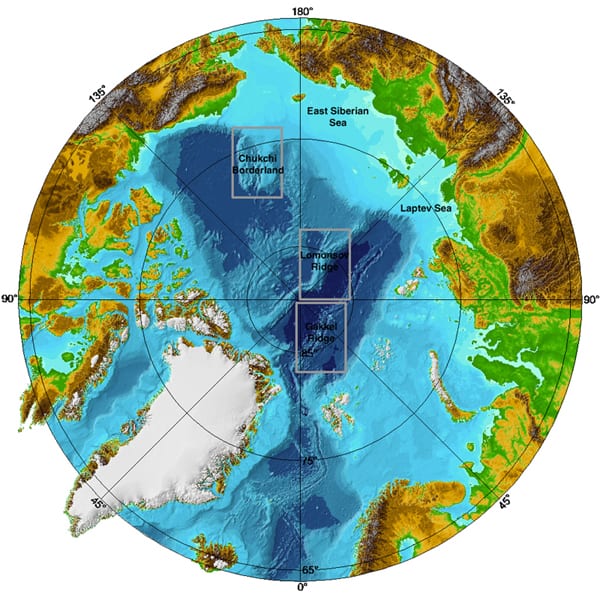International Expedition to the Top of the World May Hold Clues To Formation of Earth’s Crust
July 26, 2001
When the new U.S. Coast Guard icebreaker HEALY departs Tromso, Norway, July 31 for a two-month cruise across the Arctic Ocean, scientists won’t be studying the ice cap but the seafloor far below. Their focus will be the Gakkel Ridge, three miles beneath the ocean surface, the slowest spreading ridge on earth. It is a window into the earth’s interior scientists hope will help fill a gap in their knowledge of how the earth’s crust forms.
The expedition, funded by the National Science Foundation’s Office of Polar Programs, has been a long time coming for Senior Scientist Henry Dick of the Woods Hole Oceanographic Institution (WHOI), who first proposed studying the ridge some 15 years ago. Dick is a co-principal investigator on the cruise, and will be working with Chief Scientist Peter Michael of the University of Tulsa and fellow co-principal investigators Charles Langmuir and Steven Goldstein of the Lamont-Doherty Earth Observatory at Columbia University and David Graham of Oregon State University. The U.S. team will be working jointly with an international scientific team aboard the German icebreaker POLARSTERN.
“Mid-ocean ridges are a means to sample the earth’s deep interior,” Dick says. “They girdle the planet, like the seams on a baseball, and are where new crust is formed. Energy is transferred along the ridges from the earth’s interior to the surface, helping the planet cool itself but also resulting in volcanic activity and the formation of hydrothermal vents with their exotic marine life. Many clues about how the Earth is evolving and changing to links to the origins of life on earth may be found here, yet humans have explored very little of it.”
The Gakkel Ridge is an ultra slow spreading ridge, meaning it is spreading less than one centimeter a year, as compared to the fastest spreading ridges in the Pacific Ocean, which spread 20 times faster, or about as fast as your fingernails grow.
“I am expecting to find a lot of hydrothermal vent activity in the Arctic because this is tectonically controlled, and with so little magma coming out of the ridge it is just like a great big crack in the earth. Scientists previously thought there was little volcanic activity along the Gakkel Ridge, but information from a 1999 submarine cruise indicates there may be an isolated, very large megavolcano at the eastern end of the ridge filling up the crack,” Dick says. “The Gakkel Ridge is spreading so slowly that ocean crust doesn¹t form as it does on other parts of the mid-ocean ridge. Instead the mantle is spreading right onto the sea floor. If we could see it, it would look like giant slabs of a grass green rock called peridotite, made mostly of olivine (familiar to many as the gemstone peridotite), rising out of the sea floor about a mile high and over a distance of about 25 miles. The Gakkel Ridge is like no other in the world.”
The scientists will try to recover volcanic rock samples from the sea floor along some 500 miles of the ridge by cracking through the ice with the two ships, one making a path for the other, to lower a cable to the sea floor to grab some rock samples. Because of the difficulties they face in such an effort, a number of innovative sampling tools have been designed and built at WHOI by James Broda, who will be aboard the ship, and Institution colleagues for this first major sampling cruise on the ridge. With unofficial names like “Bed of Nails,” the tools were not designed for beauty but to be practical, able to get through the ice cover into water some 4 kilometers (about two and a half miles) deep and hard rock on the ocean floor below. Only two samples have been collected at the ridge by German scientists, both by piston coring, so little is known about the ridge and the processes shaping the earth’s surface.
“The Gakkel Ridge is unique because it is virtually unsampled,” Dick says. “It is located in a very hostile environment, and logistics have prevented us from getting there until now. With the new capabilities of the Coast Guard icebreaker HEALY, U.S. scientists will be able to collect the samples needed to address major questions about the formation of the mid-ocean ridge, the largest geological feature on the planet.”
“About one-third of the sea floor is formed at very slow and ultra slow spreading ridges like the Gakkel Ridge,” Dick adds. “The thickness of the ocean crust is highly variable and unknown, and the exchange of magma and gases from the earth’s interior to the sea floor appears to be less than we had thought. Understanding the role of ocean ridge formation is critical to understanding the global geochemical cycle, even to understanding global change.
The 420-foot HEALY will travel some 800 miles from Norway to the edge of the ice cap in three days at 12 knots, typical speed for a research vessel. Once in the ice, however, the speed will slow to a few knots, or a few miles per hour, depending on the thickness of the ice cap. The HEALY and POLARSTERN will work in tandem sampling across the Arctic, hoping to get close to the North Pole. They plan to sample along some 500 miles of the ridge before returning to Tromso in early October.
“For years many people thought that most of the earth’s crust was uniform, like a layer cake. What we have found out in the past few decades has totally changed that view, and I expect the results of this cruise will further change our views.” Dick says. “At the least, it will be an incredible adventure!”

